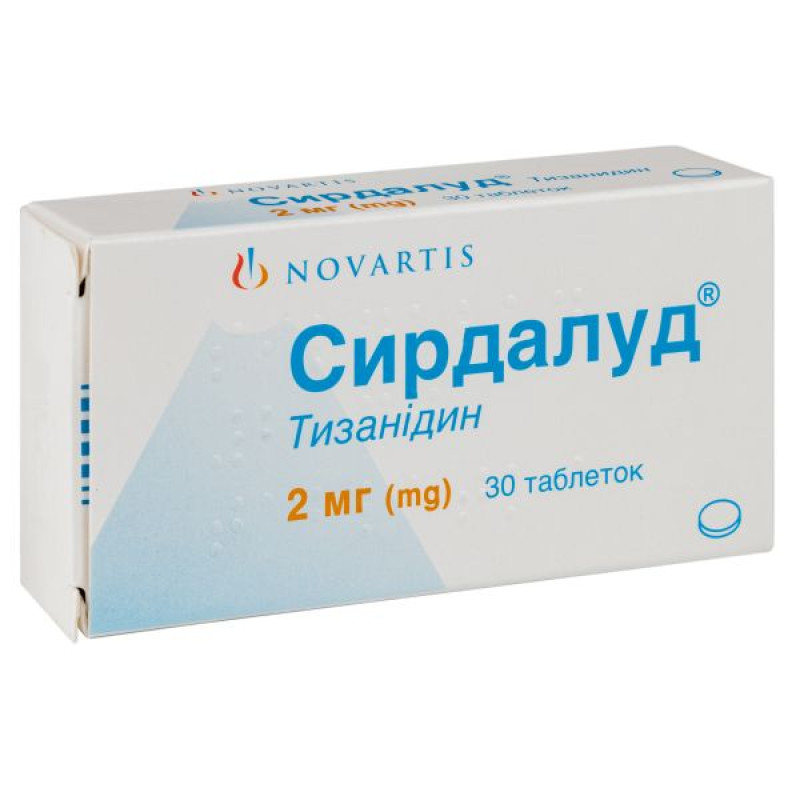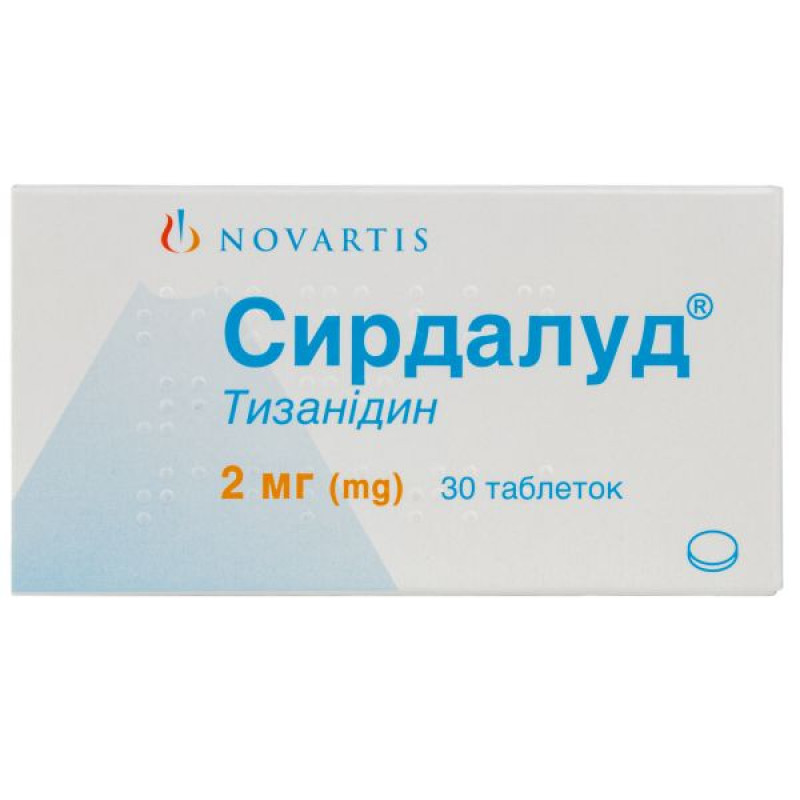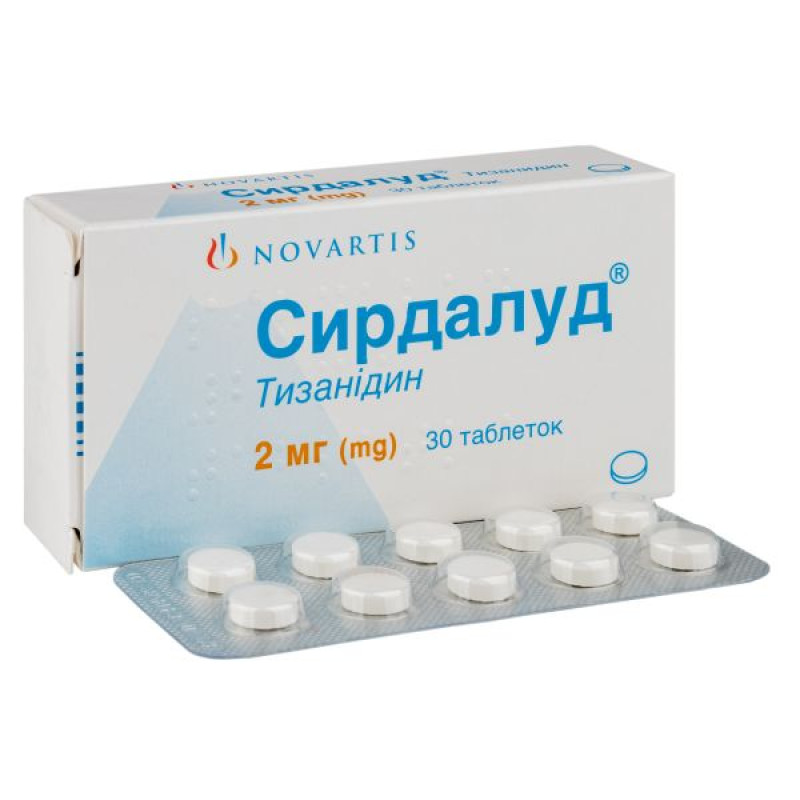Sirdalud tablets 2 mg blister No. 30

Instructions for use Sirdalud tablets 2 mg blister No. 30
Composition
active ingredient: tizanidine;
1 tablet contains 2.288 mg or 4.576 mg of tizanidine hydrochloride, corresponding to 2 mg or 4 mg of tizanidine, respectively;
excipients: anhydrous lactose, microcrystalline cellulose, stearic acid, colloidal anhydrous silicon dioxide.
Dosage form
Pills.
Main physicochemical properties:
Sirdalud® 2 mg – white or almost white, round, flat tablets with beveled edges, with a score and the inscription “OZ” on one side of the tablet;
Sirdalud® 4 mg – white or almost white, round, flat tablets with beveled edges, with cross-scores on one side and the inscription “RL” on the other side of the tablet.
Pharmacotherapeutic group
Centrally acting muscle relaxants. ATX code M03B X02.
Pharmacological properties
Pharmacodynamics
Tizanidine is a centrally acting skeletal muscle relaxant. Its main site of action is the spinal cord. By stimulating presynaptic α-2-adrenoreceptors, it inhibits the release of excitatory amino acids that stimulate N-methyl-D-aspartate receptors (NMDA receptors). As a result, polysynaptic signal transmission at the level of interneuronal connections in the spinal cord, which is responsible for excessive muscle tone, is inhibited, and muscle tone is reduced. Sirdalud® is effective in both acute painful muscle spasms and chronic spasticity of spinal and cerebral origin. It reduces resistance to passive movements, suppresses spasm and clonic seizures, and improves the strength of active muscle contractions.
Pharmacokinetics
Absorption and distribution. Tizanidine is rapidly absorbed. Peak plasma concentrations are reached approximately 1 hour after administration. The mean absolute bioavailability is 34%. The mean steady-state volume of distribution (Vss) after intravenous administration is 2.6 L/kg. Plasma protein binding is 30%. The relatively low interpatient variability in pharmacokinetic parameters (Cmax and AUC) facilitates reliable preliminary estimation of plasma levels after oral administration.
Metabolism/Excretion. The drug undergoes rapid and extensive metabolism in the liver. Tizanidine is metabolized in vitro primarily by CYP1A2. The metabolites are inactive. They are excreted mainly by the kidneys (70%). Elimination of total radioactivity (i.e., parent compound and metabolites) is biphasic, with a rapid initial phase (half-life t1/2 = 2.5 hours) and a slower elimination phase (t1/2 = 22 hours). Only a small amount of parent compound (about 2.7%) is excreted by the kidneys. The mean half-life of parent compound is 2-4 hours.
Pharmacokinetics in specific patient groups. In patients with renal insufficiency (creatinine clearance less than 25 ml/min), the mean maximum plasma concentration is twice as high as in healthy volunteers, and the terminal half-life is prolonged to approximately 14 hours, resulting in an average 6-fold increase in the area under the concentration-time curve (AUC).
Studies in patients with hepatic impairment have not been conducted.
Tizanidine is metabolized by the CYP1A2 isoenzyme in the liver. Patients with impaired liver function may experience higher plasma concentrations of the substance.
Sirdalud® is contraindicated in patients with severe liver dysfunction.
Pharmacokinetic data in elderly patients are limited.
Gender does not affect the pharmacokinetic properties of tizanidine.
The effect of ethnicity and race on the pharmacokinetics of tizanidine has not been studied.
Food effect. Concomitant food intake does not affect the pharmacokinetic profile of Sirdalud® tablets. Although the maximum concentration value increases by a third, this is not clinically significant. No significant effect on absorption was observed.
Indication
· Painful muscle spasm.
Spasticity due to multiple sclerosis.
Spasticity due to spinal cord injuries.
Spasticity due to brain damage.
Contraindication
Hypersensitivity to tizanidine or to any of the excipients of the drug. Severe hepatic impairment. Concomitant use of tizanidine with potent CYP1A2 inhibitors such as fluvoxamine or ciprofloxacin.
Interaction with other medicinal products and other types of interactions
Concomitant use of known CYP1A2 inhibitors may increase tizanidine plasma levels. Increased tizanidine plasma levels may lead to symptoms of overdose, such as QT prolongation.
Concomitant use of potent CYP1A2 inhibitors such as fluvoxamine or ciprofloxacin with tizanidine is contraindicated. Concomitant use of tizanidine with fluvoxamine increases the AUC of tizanidine by 33-fold, while concomitant use of tizanidine with ciprofloxacin increases the AUC of tizanidine by 10-fold. This may result in a clinically significant and prolonged decrease in arterial pressure, accompanied by drowsiness, dizziness, and decreased psychomotor performance.
Concomitant use of tizanidine with other CYP1A2 inhibitors, such as antiarrhythmics (amiodarone, mexiletine, propafenone), cimetidine, some fluoroquinolones (enoxacin, pefloxacin, norfloxacin), rofecoxib, oral contraceptives, and ticlopidine, is not recommended.
Increased plasma levels of tizanidine may cause symptoms of overdose, including QT prolongation.
Concomitant use of Sirdalud® with antihypertensive drugs, including diuretics, may occasionally cause hypotension and bradycardia. In some patients receiving concomitant treatment with antihypertensive drugs, rebound hypertension and rebound tachycardia have been observed upon abrupt withdrawal of tizanidine. In isolated cases, rebound hypertension may lead to stroke.
Concomitant use of Sirdalud® with rifampicin may result in a 50% decrease in tizanidine concentrations. Thus, the therapeutic effect may be reduced when rifampicin is used during Sirdalud® therapy, which may be clinically significant in some patients. Prolonged concomitant use should be avoided, and if necessary, dosage adjustments should be made with great caution.
The use of Sirdalud® leads to a 30% reduction in systemic exposure to tizanidine in men who smoke (more than 10 cigarettes per day). Long-term use of the drug in men who smoke a lot requires the appointment of higher doses of the drug.
The simultaneous use of Sirdalud® and other centrally acting drugs (e.g. sedatives and hypnotics (benzodiazepines or baclofen), some antihistamines and analgesics, psychotropic drugs, narcotics) may enhance the effects of each drug and enhance the hypnotic effect of Sirdalud®. This applies, in particular, to the simultaneous use of alcohol, which may unpredictably change or enhance the effect of Sirdalud® and increase the risk of adverse reactions, so you should refrain from drinking alcohol,
The use of Sirdalud® with α-2 adrenergic agonists (e.g. clonidine) should be avoided due to their potential additive hypotensive effect.
Application features
Concomitant use of CYP1A2 inhibitors with tizanidine is not recommended.
After abrupt withdrawal of the drug or rapid dose reduction, patients may experience hypertension and tachycardia. In rare cases, such rebound hypertension may lead to stroke. Tizanidine treatment should not be discontinued abruptly, but only by gradually reducing the dose.
For patients with renal insufficiency (creatinine clearance < 25 ml/min), the recommended initial dose is 2 mg once daily. The dose should be increased gradually, in small "steps", taking into account efficacy and tolerability. To achieve a more pronounced effect, it is recommended to first increase the dose, which is prescribed 1 time per day, and then increase the frequency of administration.
Hepatic failure has been reported in association with tizanidine, but was rare in patients receiving daily doses up to 12 mg. Therefore, it is recommended that liver function be monitored monthly for the first four months of therapy in patients receiving tizanidine at doses of 12 mg or higher and in patients with clinical symptoms suggestive of hepatic failure (e.g. nausea, loss of appetite, or unexplained fatigue). Sirdalud® should be discontinued if serum ALT or AST levels exceed 3 times the upper limit of normal for a prolonged period.
Hypotension may occur with tizanidine and as a result of drug interactions with CYP1A2 inhibitors and/or antihypertensive drugs. Severe cases of hypotension, such as loss of consciousness and circulatory collapse, have been reported.
Caution should be exercised when using this drug with agents that prolong the QT interval (e.g. cisapride, amitriptyline, azithromycin).
Caution is required in patients with ischemic heart disease and/or heart failure. ECG monitoring should be performed at regular intervals when starting Sirdalud® in such patients.
Before using this drug in patients with myasthenia gravis, the risk-benefit ratio should be carefully assessed.
Experience in children and adolescents is limited, and therefore the use of Sirdalud® is not recommended in this category of patients.
Sirdalud® tablets contain lactose. Patients with rare hereditary diseases - galactose intolerance, severe lactase deficiency or glucose-galactose malabsorption syndrome - should not take Sirdalud® tablets.
Use during pregnancy or breastfeeding
Pregnancy.
Data on the use of Sirdalud® in pregnant women are limited, therefore it should not be prescribed during pregnancy, except in cases where the potential benefit to the mother outweighs the possible risk to the fetus.
Breast-feeding.
No teratogenic effects were observed when tizanidine was used in rats and rabbits. Animal studies have shown that tizanidine passes into breast milk in small amounts. Therefore, the drug should not be prescribed to women who are breastfeeding.
Fertility.
No impairment of fertility was observed in male rats treated with 10 mg/kg/day or in female rats treated with 3 mg/kg/day. Impaired fertility was observed in male rats treated with 30 mg/kg/day and in female rats treated with 10 mg/kg/day. Sedation, weight loss, and ataxia were also observed at these doses.
Ability to influence reaction speed when driving vehicles or other mechanisms
Tizanidine may cause drowsiness, dizziness and/or hypotension, thus impairing the patient's ability to drive or operate machinery. The risks are increased by concomitant use of alcohol.
Therefore, you should refrain from activities that require high concentration of attention and quick reactions, such as driving vehicles or working with machines and mechanisms.
Method of administration and doses
Silarud has a narrow therapeutic range and high variability of plasma concentrations of tizanidine in different patients. Therefore, it is important to use optimal doses according to the patient's needs. Treatment should be started with a low dose of 2 mg, which makes the risk of undesirable effects from taking the drug minimal. If necessary, the dose of the drug should be gradually increased, observing all necessary precautions.
Adults
Relieving painful muscle spasms
Use 2-4 mg 3 times a day. In severe cases, an additional dose of 2 or 4 mg may be taken at bedtime.
Spasticity in neurological disorders
The dose must be selected individually for each patient.
The initial daily dose should not exceed 6 mg, divided into 3 doses. It can be increased gradually to 2-4 mg twice gradually at intervals of 3-7 days. Usually the optimal therapeutic effect is achieved with a daily dose of 12-24 mg, divided into 3 or 4 doses. The total daily dose should not exceed 36 mg.
Special patient populations
Use in children and adolescents
Experience with the use of Sirdalud® in children and adolescents is limited, therefore the drug is not recommended for use in children and adolescents.
Use in elderly patients
Experience with the use of the drug in elderly patients is limited, therefore caution should be exercised when using Sirdalud® in this category of patients. It is recommended to start treatment with the lowest dose and gradually increase it with caution in “small steps” until the optimal ratio of individual tolerability and therapeutic efficacy of the drug is achieved.
Use in patients with renal impairment
For patients with impaired renal function (CC <25 ml/min), the recommended initial single daily therapeutic dose is 2 mg. The dose should be increased gradually and with caution in small steps until the optimal ratio of individual tolerability and therapeutic efficacy of the drug is achieved. In order to increase therapeutic efficacy, a single dose should first be increased before switching to a more frequent daily dose.
Use in patients with impaired liver function
Treatment of patients with severe liver dysfunction is contraindicated. Sirdalud is extensively metabolized in the liver. Sirdalud should be used with caution in patients with moderate liver dysfunction. Treatment should be initiated at the lowest dosage: any possible dose increase should be done with caution and based on the patient's individual tolerance to Sirdalud.
Treatment interruption
If it is necessary to discontinue treatment with the drug, the dose should be reduced slowly and gradually. This is especially true for patients who have been receiving an increased dose of the drug for a long time. This reduces the risk of developing a rebound increase in blood pressure and tachycardia.
Children
Experience with the use of the drug in pediatrics is limited. It is not recommended to prescribe Sirdalud® to children.
Overdose
Very few reports of overdose with Sirdalud® have been received. All patients in whom isolated cases of overdose with this drug have been reported, including 1 patient who took 400 mg of Sirdalud®, recovered without complications.
Treatment: multiple high-dose administration of activated charcoal is recommended to remove the drug from the body. Forced diuresis may accelerate the elimination of the drug. Further symptomatic treatment should be carried out.
Adverse reactions
Adverse reactions – such as drowsiness, fatigue, dizziness, dry mouth, low blood pressure, nausea, gastrointestinal disturbances and increased serum transaminase levels – are usually mild and transient in patients taking the low doses recommended for the relief of painful muscle spasm.
At doses higher than those recommended for the treatment of spasticity, the above adverse reactions occur more frequently and more pronouncedly, but they are rarely serious enough to require discontinuation of treatment. The following adverse reactions may also occur: hypotension, bradycardia, muscle weakness, sleep disturbances, hallucinations and hepatitis.
The occurrence of such symptoms has been reported after abrupt withdrawal of tizanidine, particularly after long-term treatment and/or high daily doses and/or concomitant therapy with antihypertensive drugs. In such circumstances, patients may develop hypertension and tachycardia. In isolated cases, such rebound hypertension may lead to stroke. Therefore, treatment with tizanidine should not be discontinued abruptly, but only by gradual dose reduction.
The following classification was used to estimate the frequency of occurrence of various adverse reactions: very common (≥ 1/10); common (≥ 1/100, < 1/10); uncommon (≥ 1/1000, < 1/100);
rare (≥ 1/10,000, <1/1,000); very rare (<1/10,000), including isolated reports.
Psychiatric disorders: often - insomnia, sleep disorders; frequency unknown - hallucinations.
From the side of the central nervous system: very often - drowsiness, dizziness; frequency unknown - confusion, vertigo.
From the cardiovascular system: often - arterial hypotension; infrequently - bradycardia; frequency unknown - syncope.
From the gastrointestinal tract: very often - dry mouth, gastrointestinal pain, gastrointestinal disorders; often - nausea.
Hepatobiliary disorders: often - increased serum transaminase levels; frequency unknown - acute hepatitis, hepatic failure.
Musculoskeletal system: very often - muscle weakness.
General disorders: very often - increased fatigue; frequency unknown - asthenia, withdrawal syndrome, possible occurrence of hypersensitivity reactions.
On the part of the organs of vision: frequency unknown - blurred vision.
Investigations: common: decreased blood pressure, increased transaminase levels.
Expiration date
5 years.
Storage conditions
Store at a temperature not exceeding 25 ºС, out of the reach of children.
Packaging
10 tablets in a blister; 3 blisters in a pack.
Vacation category
According to the recipe.
Producer
Novartis Saglik, Gida ve Tarim Urunleri San. Ve Tic. A.S./Novartis Saglik, Gida Ve Tarim Urunleri San. Ve Tic. AS
Location of the manufacturer and its business address
Yenisehir Mah Dedepasa Cad No. 17 (11. Sok No. 2), Kurtkoy, Istanbul, TR 34912, Turkey.
There are no reviews for this product.
There are no reviews for this product, be the first to leave your review.
No questions about this product, be the first and ask your question.









